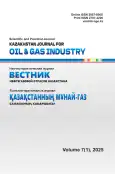Algorithm for determining the mass flow rate and dryness of the thermal agent at the wellhead of steam injection wells in specialized software
- Authors: Yerlepessov M.U.1, Yermekov A.A.1, Amirov S.K.1
-
Affiliations:
- Branch of KMG Engineering LLP KazNIPImunaigaz
- Issue: Vol 7, No 1 (2025)
- Pages: 54-65
- Section: Oil and gas field development and exploitation
- URL: https://journal-vniispk.ru/2707-4226/article/view/293580
- DOI: https://doi.org/10.54859/kjogi108736
- ID: 293580
Cite item
Full Text
Abstract
Background: Determining the mass flow rate and dryness of thermal agent at the wellhead of steam injection wells is a critical process in the operation, optimization and effective control of its injection regulation. In view of the fact that modern steam flow rate determination instruments based on measurement of variable flow of two-phase medium (steam and water), having a methodological error of more than 10%, cannot provide the necessary accuracy and reliability of measurements, there was a need to develop a calculation variant with the use of specialized software that would allow to correctly solve the problem of determining the degree of steam dryness.
Aim: Development of an algorithm for calculation of mass flow rate and dryness of thermal agent at the wellhead of steam injection wells of the K field using specialized software.
Materials and methods: Two-phase flow of steam and water in wells is a complex process, where it is important to take into account both physical properties of the medium (temperature, pressure, viscosity) and hydraulic characteristics of the system (resistance of pipelines, pressure losses). Mathematical simulation of two-phase flow “steam – water” was performed in a specialized software package by building a ground model and conducting hydraulic calculations. This specialized software complex allowed to build a mathematical model taking into account these parameters, which provides high accuracy and reliability of calculations.
Results: An algorithm for calculating the mass flow rate and dryness of the thermal agent at the wellhead of steam injection wells of the K field based on the model of the onshore steam injection system through the use of a specialized software package has been developed. Simulation allows predicting and optimizing the operation of steam injection wells. By changing model parameters (e.g., production mode, coolant parameters), the impact on well performance and system efficiency can be evaluated.
Conclusion: To date, it has not been possible to select equipment that allows correct registration of the two-phase flow of steam-heat agent injected into wells, which is typical for the conditions of the K field. The algorithm developed with the help of a specialized software package is applicable in the formation of technical solutions to improve the efficiency of control of steam injection process regulation.
Full Text
##article.viewOnOriginalSite##About the authors
Murat U. Yerlepessov
Branch of KMG Engineering LLP KazNIPImunaigaz
Email: m.yerlepessov@kmge.kz
ORCID iD: 0009-0007-8581-2786
Kazakhstan, Aktau
Abay A. Yermekov
Branch of KMG Engineering LLP KazNIPImunaigaz
Email: A.Yermekov@kmge.kz
ORCID iD: 0009-0003-2130-2489
Kazakhstan, Aktau
Sain K. Amirov
Branch of KMG Engineering LLP KazNIPImunaigaz
Author for correspondence.
Email: s.amirov@kmge.kz
ORCID iD: 0009-0005-7771-5535
Kazakhstan, Aktau
References
- Abarinov YG, Sarelo KS. Metodicheskiye pogreshnosti izmereniya energii vlazhnogo para teploschetchikami na sukhoy nasyshchennyy par. Izmeritel’naya tekhnika. 2002;3. (In Russ).
- kep-products.ru [Internet]. Kessler-Ellis Products Co. Inc. : Principles of steam flow measurement. Background information. Measurement of steam flow [cited 2023 Dec 25]. Available from: https://kep-products.ru/meriem-rashod-para/500-podhodi-k-izmerenija-rashoda-para.html. (In Russ).
- Sychev G. Izmereniye raskhoda vlazhnogo para. Spiraskop. 2012;2:6–8. (In Russ).
- metronic.ru [Internet] Metronic: Sistema izmereniya sukhosti para [cited 2013 Dec 12]. Available from: http://www.metronic.ru/stat/st012.html. (In Russ).
- Kovalenko AV. Matematicheskaya model dvuhfaznogo techeniya vlazhnogo para v paroprovodah. Uchyot energonositeley. 2011. Availbale from: https://www.rosteplo.ru/Tech_stat/stat_shablon.php?id=2424. (In Russ).
- Romanov AY, Tsaplin SV, Bolychev SA, Popkov VI. Matematicheskaya model’ teplomassoperenosa v paronagnetatel’noj skvazhine. Oil & Gas. 2013;4. (In Russ).
- Khasani I, Harijoko A, Dwikorianto T, Patangke S. Development of measurement method of steam-water two-phase flow system using single frequency waves. Proceedings of 35th Workshop on Geothermal Reservoir Engineering Stanford University; 2010 Feb 1–3; Stanford University, Stanford, USA. Available from: https://es.stanford.edu/ERE/pdf/IGAstandard/SGW/2010/khasani.pdf.
- Sadykov AF. Multiphase Flow Simulator PIPESIM – a complete set of workflows for modeling production operations. Oil. Gas. Innovations. 2019;12:36–40. (In Russ).
- digital.slb.ru [Internet]. Schlumberger: PIPESIM User’s Guide. Version 2020.1 [cited 2023 Dec 26]. Available from: https://digital.slb.ru/products/pipesim/pipesim_2020_1/.(In Russ).
- Yermekov AA, Baspayeva AT, Amirov SK. Application of simulation to optimize the oil-gathering system of the “N” oil field. Kazakhstan journal for oil & gas industry. 2023;5(1):94–102. doi: 10.54859/kjogi108599. (In Russ).
- Zakenov ST, Yermekov АА, Nurshakhanova LK, Aijanova SS. Convergence Issues of Hydrodynamic Models of Reservoir Pressure Maintenance Systems. Oil and Gas Technologies. 2021;4:32–36. doi: 10.32935/1815-2600-2021-135-4-32-35. (In Russ).
Supplementary files

















